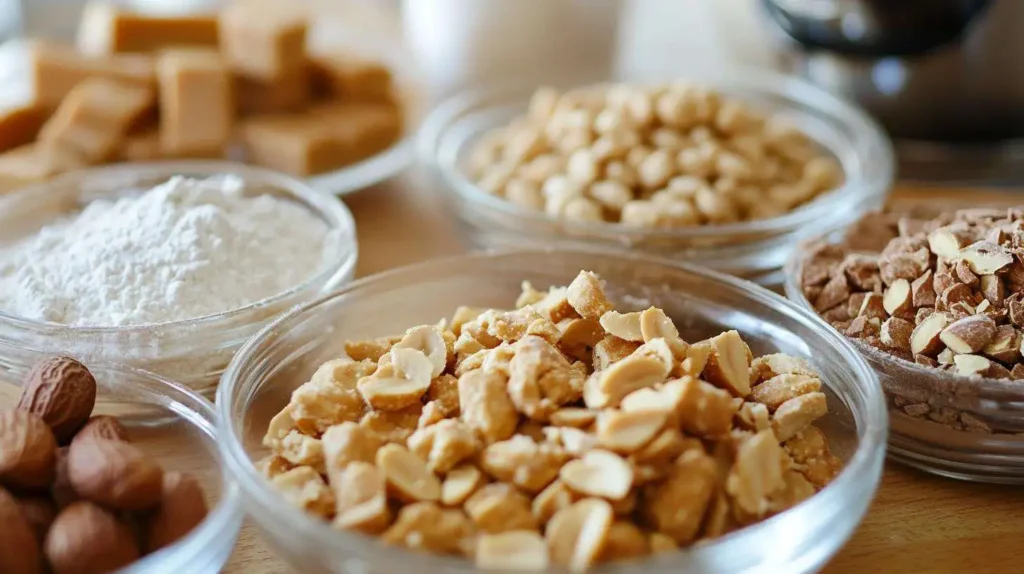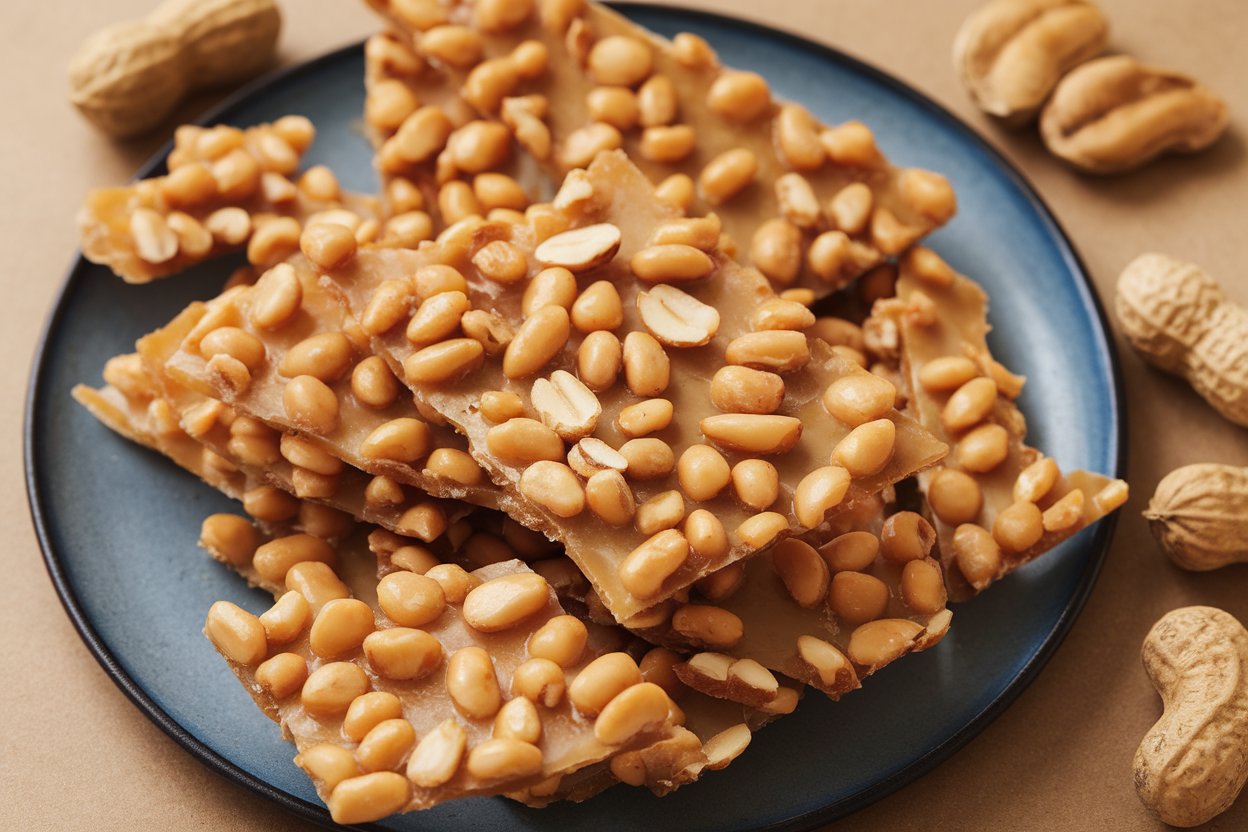Peanut brittle is one of those timeless treats that just hits the sweet spot, isn’t it? Whether you’ve tasted it during the holidays or as a surprise snack from Grandma’s candy jar, it’s hard to resist that crunchy, sweet, and nutty goodness. But here’s the thing—peanut brittle isn’t just a dessert; it’s a journey into the heart of candy-making. In this guide, we’ll explore everything you need to know about peanut brittle, from its origins to making it at home, troubleshooting common issues, and even some creative twists. Let’s dive in!
Table of Contents
What is Peanut Brittle?
The History of Peanut Brittle
Have you ever wondered where peanut brittle came from? The exact origin story might be a bit hazy, but many believe it dates back centuries, with variations found in different cultures. Some say it started in the United States in the 19th century, while others trace its roots to older Middle Eastern and Asian recipes. Regardless of where it began, one thing’s for sure: peanut brittle has become a universally loved treat.
“Peanut brittle is more than candy—it’s a crunchy piece of history.”
What Makes Peanut Brittle Unique
What sets peanut brittle apart from other candies? It’s all about the texture. The combination of caramelized sugar, buttery richness, and roasted peanuts creates a hard yet brittle texture that melts in your mouth. Unlike fudge or toffee, peanut brittle has that satisfying “snap” when you break it.
Ingredients for Perfect Peanut Brittle

Let’s talk ingredients. Peanut brittle doesn’t require a long shopping list—most of the items are probably already in your pantry. Here’s a quick breakdown:
| Ingredient | Quantity |
|---|---|
| Granulated sugar | 2 cups |
| Light corn syrup | 1 cup |
| Water | 1/2 cup |
| Unsalted butter | 2 tablespoons |
| Raw peanuts (shelled) | 2 cups |
| Baking soda | 1 teaspoon |
| Vanilla extract | 1 teaspoon |
| Salt | 1/4 teaspoon |
Optional Add-Ins for Creative Twists
Want to get fancy? Try these:
- Chocolate drizzle: Melt some chocolate and drizzle it over the brittle.
- Spices: Add cinnamon or a pinch of cayenne for a unique flavor.
- Mixed nuts: Substitute peanuts with almonds, cashews, or pecans.
How to Make Peanut Brittle at Home
Making peanut brittle might seem intimidating, but trust me—it’s easier than you think. Just follow this step-by-step guide, and you’ll nail it like a pro.
Step-by-Step Guide for Beginners
- Prepare Your Workspace
Start by lining a baking sheet with parchment paper or a silicone mat. This will prevent the brittle from sticking. Also, measure out all your ingredients in advance (you don’t want to scramble once things heat up). - Mix the Base
In a large saucepan, combine sugar, corn syrup, and water. Stir until the sugar dissolves, then turn the heat to medium-high. - Cook to the Right Temperature
Here’s where it gets a little science-y. Attach a candy thermometer to the pan and cook the mixture until it reaches 300°F (the hard crack stage). This is what gives brittle its signature crunch. - Add the Good Stuff
Once the temperature is right, quickly stir in butter, peanuts, baking soda, vanilla, and salt. The baking soda will cause the mixture to foam up—that’s normal! It’s what gives the brittle a light, airy texture. - Spread and Cool
Pour the hot mixture onto your prepared baking sheet. Use a spatula to spread it thinly. Let it cool completely (about 30 minutes), then break it into pieces.
Common Mistakes and How to Avoid Them
Even seasoned candy-makers can hit a snag when making peanut brittle. Here are a few common problems and how to fix them:
Peanut Brittle Too Soft
Did your brittle end up chewy instead of crunchy? That usually means the sugar mixture didn’t reach the hard crack stage. Next time, double-check your thermometer and make sure it hits 300°F.
Peanut Brittle Sticking to the Pan
If you skipped lining your pan, you might end up with brittle that refuses to budge. Always use parchment paper or a silicone mat for an easy release.
Burnt Peanut Brittle
Burnt sugar isn’t fun. If your brittle tastes bitter, it’s likely because the mixture cooked too long or too hot. Keep an eye on the thermometer and work quickly once the temperature is right.
“Candy-making is like a dance—timing and precision make all the difference!”
The Science Behind Peanut Brittle
Candy-making might feel like magic, but it’s actually chemistry at work. When sugar heats up, it goes through different stages, each with unique properties. For peanut brittle, you’re aiming for the hard crack stage, where the sugar becomes brittle and snaps when cooled.
Understanding Sugar Stages
- Soft Ball (235°F–245°F): Think caramel or fudge.
- Hard Ball (250°F–265°F): Used for chewy candies.
- Hard Crack (300°F): Perfect for brittle!
Why Temperature Control is Critical
If the sugar doesn’t reach 300°F, your brittle will be soft and sticky. Go too high, and it burns. A candy thermometer is your best friend here—don’t skip it!
Popular Variations of Peanut Brittle
While classic peanut brittle is always a winner, there’s no harm in getting creative. Here are a few fun variations to try:
Classic Peanut Brittle
The original recipe is all about simplicity: peanuts, sugar, and buttery goodness. It’s a crowd-pleaser for a reason.
Chocolate-Dipped Peanut Brittle
Want to take it up a notch? Once your brittle cools, dip the pieces in melted chocolate. Let it set, and you’ve got a gourmet treat.
Vegan and Gluten-Free Peanut Brittle
Making peanut brittle for dietary restrictions? Swap butter with coconut oil, and make sure your ingredients are gluten-free. Easy peasy!
Peanut Brittle Storage and Shelf Life
Once you’ve made your delicious peanut brittle, the next question is: how do you store it to keep it fresh and crunchy? The good news is that peanut brittle has a pretty long shelf life if stored properly. Let’s break it down.
Best Ways to Store Peanut Brittle
To keep your peanut brittle in tip-top shape, follow these simple tips:
- Cool Completely
Before storing, ensure your brittle has cooled completely. If it’s even slightly warm, it can create moisture, making it sticky. - Use Airtight Containers
Store your brittle in an airtight container to keep moisture out. Glass or plastic containers with tight-fitting lids work perfectly. - Avoid the Fridge
While it might seem like a good idea, refrigeration can actually make peanut brittle soft and sticky because of condensation.
Can You Freeze Peanut Brittle?
Yes, you can! Freezing peanut brittle is a great way to extend its shelf life. Simply place it in an airtight container, separating layers with parchment paper. When ready to eat, let it come to room temperature to regain its crunch.
“Pro tip: Store brittle in a cool, dry place, and it’ll stay fresh for weeks—or even months!”
Health Considerations and Nutritional Facts
Let’s face it—peanut brittle isn’t exactly a health food. But hey, it’s a treat, and everyone deserves a little indulgence now and then. Still, it’s good to know what you’re munching on.
Is Peanut Brittle Healthy?
While peanut brittle is high in sugar and calories, it does have a few redeeming qualities. Peanuts are packed with protein, healthy fats, and vitamins. So, while it’s not something to eat daily, it can be enjoyed in moderation.
Nutritional Facts
Here’s a quick overview of the nutritional content of a typical serving (1 ounce, about 2-3 pieces):
| Nutrient | Amount |
|---|---|
| Calories | 150 |
| Total Fat | 7g |
| Saturated Fat | 2g |
| Sodium | 60mg |
| Carbohydrates | 20g |
| Sugar | 18g |
| Protein | 3g |
Tips for Moderation and Portion Control
- Break brittle into smaller pieces to satisfy your sweet tooth without overindulging.
- Pair it with a glass of milk or tea to make a small portion feel more satisfying.
Peanut Brittle in Culture and Traditions
Peanut brittle isn’t just a dessert—it’s a cultural icon in many parts of the world. Let’s explore how this beloved treat fits into traditions and celebrations.
Holiday and Festive Uses
Peanut brittle is a staple during holidays like Christmas and Thanksgiving. It’s often gifted in decorative tins or added to festive dessert platters. Its golden, caramelized color even gives it a festive vibe!
Peanut Brittle as a Gift
If you’ve ever received a tin of homemade peanut brittle, you know how special it feels. It’s an inexpensive yet thoughtful gift, perfect for neighbors, teachers, or coworkers.
“Think of peanut brittle as a little package of joy—crunchy, sweet, and made with love.”
Where to Buy the Best Peanut Brittle
Not in the mood to make your own? No worries! There are plenty of places where you can buy high-quality peanut brittle.
Top Peanut Brittle Brands
- See’s Candies: Known for their classic and rich peanut brittle.
- Brittle Brothers: Famous for their thin, crispy style.
- Local Artisans: Check out farmers’ markets for handmade options.
Local vs. Online Peanut Brittle: Which is Better?
- Local: Freshly made and often supports small businesses.
- Online: Convenient and offers a wider variety of flavors and styles.
Frequently Asked Questions
Still curious? Here are some of the most common questions people have about peanut brittle.
Can I Make Peanut Brittle Without a Candy Thermometer?
Yes, but it’s trickier. You can use the “cold water test.” Drop a small amount of the hot sugar mixture into cold water—it should harden instantly and snap when you break it. Still, a candy thermometer is much more reliable.
What Nuts Can I Substitute for Peanuts?
If you’re not a fan of peanuts or have allergies, you can easily swap them out for other nuts like almonds, cashews, or pecans. You could even try seeds like sunflower or pumpkin seeds for a nut-free version.
Conclusion:
Peanut brittle isn’t just a treat; it’s an experience. From the science of caramelizing sugar to the joy of cracking that first piece, making peanut brittle at home is a rewarding (and delicious) adventure. Plus, with so many variations and uses, it’s a dessert that never gets boring.

